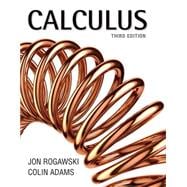Guided by new author Colin Adams, the new edition stays true to the late Jon Rogawski’s refreshing and highly effective approach, while drawing on extensive instructor and student feedback, and Adams’ three decades as a calculus teacher and author of math books for general audiences.
W. H. Freeman/Macmillan and WebAssign have partnered to deliver WebAssign Premium – a comprehensive and flexible suite of resources for your calculus course. Combining the most widely used online homework platform with the authoritative and interactive content from the textbook, WebAssign Premium extends and enhances the classroom experience for instructors and students.
Maximize Teaching and Learning with WebAssign Premium
Macmillan Learning and WebAssign have partnered to deliver WebAssign Premium – a comprehensive and flexible suite of resources for your calculus course. Combining the most widely used online homework platform with authoritative textbook content and Macmillan’s esteemed Calctools, WebAssign Premium extends and enhances the classroom experience for instructors and students. Preview course content and sample assignments at www.webassign.net/whfreeman.








